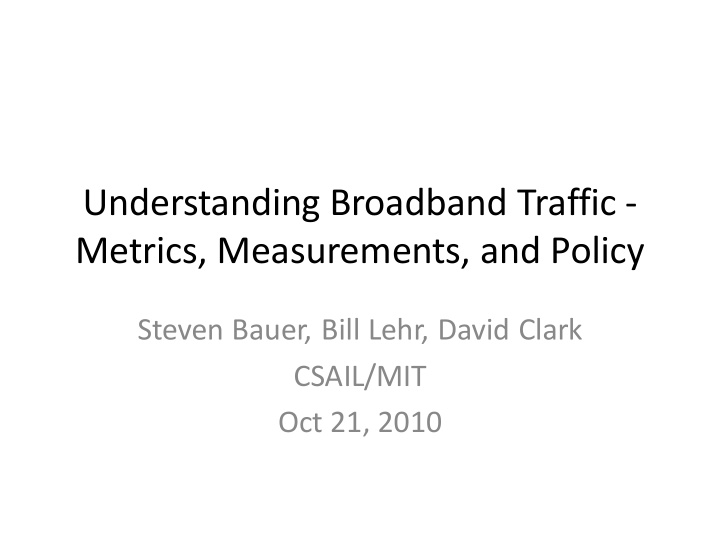



Understanding Broadband Traffic - Metrics, Measurements, and Policy Steven Bauer, Bill Lehr, David Clark CSAIL/MIT Oct 21, 2010
Outline • The story of a $100,000 bug • Why it (and hundreds of other details) matter to the FCC study of broadband • Fascinating lessons learned from simply trying to calculate an average speed for one connection • Important policy implications • Other ongoing MITAS projects that are shedding more light on broadband
The story of a $100,000 bug • Why $100,000? Derivation of a guesstimate – Assume 10 million broadband customers – 1 out of 1000 will trip over this bug a year causing them to call their broadband provider’s customer support number – 12 minutes per support call – 2000 hours of support – Necessitating one customer support representative at a fully loaded cost of $100,000
Before double clicking on “Gateway”
After double clicking on “Gateway”
Hard at work
Take an Oreo break … … and wait for connectivity to hopefully return
Grumble… 1. Try to debug this myself? 2. Call customer support?
Grumble… 1. Try to debug this further myself? 2. Call customer support?
Grumble… 1. Try to debug this even further myself? 2. Call customer support?
Conclusion… It’s my providers fault: DHCP failed to renew? • Cable modem problem? •
What actually had happened?
Double clicking invokes the default action
Disable!
Beyond $100,000 of customer support costs, why does this story matter? • Could have impacted the reliability measurements being gathered by an important larger scale study of broadband networks – On its own, a very small potential effect – But the total of hundreds of such little details matter a great deal to our ability to have confidence in the measurements
FCC broadband measurement project run by Samknows • Samknows will deploy 10,000 boxes in United States • Real tests are scheduled to start on January 1 st , 2011 • Performance tests currently planned – Web browsing – Video streaming – Voice over IP – Availability Test – UDP Latency and Packet Loss – Data Usage Test – Speed Tests – Jitter Test – ICMP Latency and Packet Loss – DNS resolution
Why does the Samknows study matter beyond the US and UK markets? • Similar EU study upcoming – Quality of Broadband services in the EU “provide information on the difference between advertised and effective speed and comparison between Member States… [and] assess the effective quality ” • Samknows is an increasingly important player in the broadband measurement area – Trials with a telecom regulator in Asia – Trials with EU ISPs – Has a deal with Thomson/Technicolor for embedding measurement software in DSL gateways
Why are we involved? “Understanding broadband speed measurements” 1. Presented at TPRC (Oct 2010) 2. Passed around the FCC 3. Submitted to the FTC 4. ISPs 5. Samknows 6. Circulated among academics 7. Cited in a proposal to the NSF 8. MIT news release 9. Reporters
Detailing MIT’s involvement in the FCC/Samknows broadband study Disclaimers Contributions • Probing test methodology • Not conducting an audit • Finding and eliminating • No authority or potential sources of responsibilities problems • No access to the full source • Offering constructive code (currently) criticism • Beginning to analyze small sets of raw data • Expect eventual access to full data set
Samknows speed measurement methodology • Tests run to on-net and nearby off-net servers • 3 simultaneous TCP connections • Measurements starts after a “warm up” period • Test finishes after a fixed time duration
Preliminary speed comparison test 1. FCC/Samknows (on-net, 10 second test) 2. Ookla/Speedtest 3. Measurement Lab/NDT 4. Iperf 2-5 all test to the same server at MIT 5. Iperf-multithreaded
Effects of Powerboost • If Powerboost is present, shorter tests will be reporting more of the “Powerboost speeds” Powerboost ends • Long durations will be slower Steeper slope is a fast speed
On-net versus off-net speed differential for download speed test Test duration (secs) Difference in average speeds (Kbps) 5 383 10 308 15 225 20 185 25 155 30 132 • Belmont MA -> Needham MA versus Belmont MA -> NYC • 7 versus 15 traceroute hops • 8 ms versus 16 ms ping times
What is the average speed of this one cable network connection? Test Average Download Speed Samknows on-net 5 second test 26.2 Samknows off-net 5 second test 25.8 Ookla/Speedtest 22.0 Iperf-multithreaded 20.1 Samknows on-net 10 second test 19.5 Samknows off-net 10 second test 19.2 Iperf 18.9 Measurement Lab’s NDT 17.4 Samknows on-net 15 second test 17.2 Samknows off-net 15 second test 17.0 Samknows on-net 20 second test 16.1 Samknows off-net 20 second test 15.9 Samknows on-net 25 second test 15.4 Samknows off-net 25 second test 15.3 Samknows on-net 30 second test 15.4 Samknows off-net 30 second test 14.8
Other ongoing MITAS data analysis • Lots more analysis work on existing data sets – MITAS provider data – Measurement Lab’s NDT data – Ookla/Speedtest data – FCC/Samknowsdata • Comparative analysis across studies
2009 NDT data
2009 NDT data Real lesson is not the ranking but the importance of round trip time (RTT) and other factors that inhibit speed
Conclusion • Lots more broadband measurement data is becoming available – First 3 months of FCC data will be released – Richer other data sets coming as well – a new broadband measurement era • Questions selected to ask of the data matter a great deal • Input into a very important discussion of broadband performance • What we measure now is going to shape the future of broadband connectivity – Regulatory policy – Consumer marketplace – Application/Service providers
Recommend
More recommend